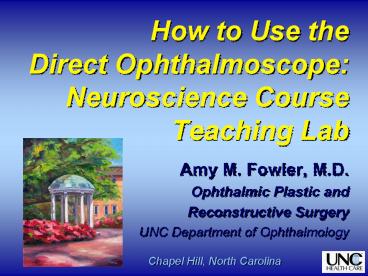How to Use the Direct Ophthalmoscope: Neuroscience Course Teaching Lab - PowerPoint PPT Presentation
1 / 16
Title:
How to Use the Direct Ophthalmoscope: Neuroscience Course Teaching Lab
Description:
Fluorescein stained abrasions are apple green in cobalt blue light. Slit light ... touch your thumb (see above) Get closer than in this photo! ... – PowerPoint PPT presentation
Number of Views:2784
Avg rating:3.5/5.0
Title: How to Use the Direct Ophthalmoscope: Neuroscience Course Teaching Lab
1
How to Use the Direct OphthalmoscopeNeuroscienc
e Course Teaching Lab
- Amy M. Fowler, M.D.
- Ophthalmic Plastic and
- Reconstructive Surgery
- UNC Department of Ophthalmology
- Chapel Hill, North Carolina
2
Objectives
- Learn correct use of the direct ophthalmoscope
- Recognize normal retinal anatomy
- Identify ocular anatomy
- Review abnormal retinal findings
- Identify pathologic findings
3
Ophthalmoscope head removable
- Dial for lens power
- Operate with index finger
- Power indication (in diopters)
- On opposite side
- Red minus power, myopia
- Black or green plus power, hyperopia
- On/off dial
- Operate with index finger
- Press button down and rotate to adjust brightness
Some models unscrew to allow wall plug in
- Handle
- Right hand for right eye
- Left hand for left eye
Bottom unscrews to replace battery
4
Some models with lens protector over viewing
window
Green filter red free (for vessels) No filter
everyday use Dimmer for photophobia
Pattern selector Small/medium/large light Blue
light Slit light Grid pattern
5
Pattern selector
- Small/medium/large light
- Determined by pupil size smaller pupil use
small light - Photophobia use smaller light for patient
comfort - Blue light
- Fluorescein stained abrasions are apple green in
cobalt blue light - Slit light
- Poor mans slit lamp
- contour
- Grid pattern
- Measure size
6
- Examiner looks through viewing side
- Place rubber flange against examiners brow
- Right eye, right hand, right eye
- Left eye, left hand, left eye
- Helpful to place free thumb on patients brow
- Stabilizes patients head
- Orients the examiner
- Instruct patient to look slightly up
- and fix at a distant target
- Find the red reflex and follow it in
- at approx. 15 degree angle temporally
- Get close - your ophthalmoscope may even
- touch your thumb (see above)
- Get closer than in this photo!
7
Anterior segment
- Higher plus power focuses closer
- Cornea
- Iris
- Lens (cataract)
- Red reflex
8
Red reflex
- Assess media opacities
- High plus power
- Focus on lens
- Newborn exam!
- Landing guide (direct ophthalmoscopy)
- Dial in minus for retina
Lens opacity Cataract
9
Vitreous body
Vitreous hemorrhage
10
Direct ophthalmoscopy
- Rotate power dial (add minus) until vasculature
starts to get into focus - Find any landmark, refine focus
- Follow vessels to disc
- Branch points serve as arrows
Abnormal Right Eye
Normal Left Eye
11
Retinal exam
- Disc
- Color (rim)
- Pink?
- Pallor?
- Contour
- Flat or elevated?
- Rim sharp or blurred?
- Nerve fiber layer- edema?
- Obscuration of vessels?
- Cup (normal 0.3 - 0.5)
Flat, pink, sharp disc CD 0.45
Disc edema
12
Increased cupping CD 0.6
Traumatic choroidal rupture
13
Vessels
Emboli
- Arteries and veins
- orange red (artery) vs. blue red (vein)
- Caliber size ratio 23 (artery-to-vein)
- Course (tortuous? beaded?)
- Crossing changes
- Hemorrhage
- flame shaped, dot /blot
- Infarct cotton wool spot
- Exudate lipid, edema
- Perivascular infiltration
Dot/blot hemorhages
AV nicking
CWS
CWS
CWS
Hypertension
14
Peripheral retina
Retinal contusion Commotio Retinae
- Difficult visualization with direct
ophthalmoscope - Hemorrhage, edema
- Nerve fiber layer infarct
- Exudation
- Pigmentation
- Scarring
Old
Diabetic laser
Recent
15
Macula - do last!
- Between vascular arcades
- Area of best vision
- Most photosensitive region
- Foveal reflex
- Drusen, RPE changes, etc.
Red-free image
Drusen
Macular degeneration
Diabetic retinopathy
16
Teaching points
- Be able to use direct ophthalmoscope
- Recognize normal vs. abnormal findings
- Describe abnormal finding
- Flame shaped hemorrhages
- Disc edematous or pale
- Remember disease processes come later
- Electives
- Clerkship































